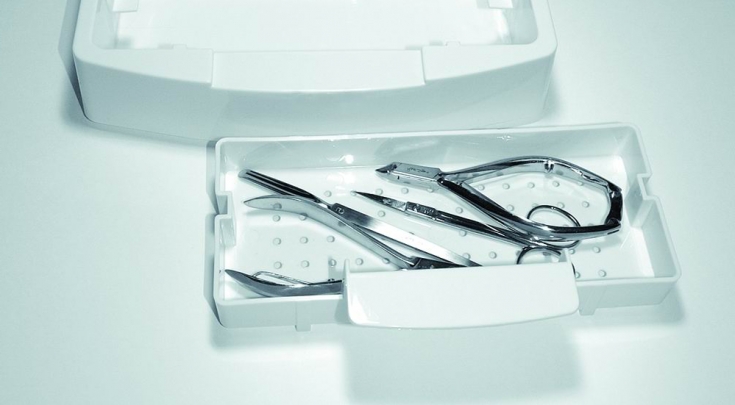Cosmetology services are experiencing a real boom. After all, not every busy lady has a free minute to do a manicure, pluck her eyebrows, clean her face and carry out other beauty activities. But when signing up for a beauty salon or a cosmetology clinic, you should be on the lookout. After all, cases have become more frequent when improperly processed tools and surfaces led to the infection of clients and the masters themselves with staphylococcus aureus, streptococcus, fungus, herpes, hepatitis or even HIV infection. Therefore, before lying down on the couch, you need to make sure that high-quality disinfection of tools and other devices has been carried out. The online publication estet-portal.com will tell you what the essence of such a procedure is and how it is carried out.
Disinfection and sterilization: how do they differ from each other
In beauty salons and aesthetic medicine clinics, procedures are performed where there is likely to be contact with blood and damaged tissues. These are very risky activities, since there is a risk of infection of the client and the employee of the institution. That is why disinfection and sterilization of instruments and work surfaces – important components of any procedures in the field of cosmetology.
The main goal of such preventive measures – destruction of bacteria, as well as infectious agents with the help of special means and a sterilizer.
In salons and clinics, everything that comes into contact with the human body and blood must be processed without fail:
• manicure and pedicure tools;
• cosmetic tools;
• facial cleaners;
• combs and scissors for cutting hair;
• curlers;
• clips;
• caps and perm nets.
The containers that are used for procedures, the surfaces of devices with their wires, as well as furniture coverings should also be treated.
But disinfection and sterilization – it's not the same thing. So, in the first case, only pathogenic microorganisms are destroyed. For this, chemicals are usually used that have a wide spectrum of antimicrobial activity. To completely destroy the forms of all microorganisms, including the hepatitis virus and HIV infection, a slightly different preventive measure is needed. And sterilization is just right. High temperatures are already being used here.
Methods and means of disinfection: what to look for
Reprocessing of reusable instruments is usually done after each client. First of all, tools, furniture and equipment are thoroughly disinfected in order to kill bacteria, germs, fungi and other microorganisms. Next comes the washing of the devices with running water, as well as their mechanical cleaning from the remnants of hair, skin, nails, and fatty traces. Then all inventory is sterilized. Particular attention should be paid to objects that have come into contact with injectables, as well as the client's blood and mucous membranes.
Disinfection, like sterilization, must be carried out in every beauty salon and in every clinic. Such an event is carried out using various methods and means. Among the most popular methods are:
• Mechanical – includes air filtration, washing of towels and overalls, cleaning and garbage removal.
• Physical – implies exposure to high temperatures (boiling, ironing) and irradiation with bactericidal lamps.
• Chemical – chemicals are used.
As practice shows, in salons and clinics, they most often resort to the chemical method. In this case, those means are used that are permitted by the Ministry of Health. In addition, they must have certificates that indicate that the products meet the requirements of state standards and technical specifications.
If surfaces need to be simply wiped down with a disinfectant, then – dip in a disinfectant solution. It is necessary to prepare such a product clearly according to the instructions, which should contain information regarding dilution proportions, shelf life of the finished product and precautions.

If you don't keep the proportions, you can not only ruin the instrument, but also get burned. Such consequences will be if the amount of active substance in the solution is exceeded. But if the disinfectant concentration is too low, the instrument will not be processed well enough.
Those products that consist of several parts are disassembled and then placed for soaking in a container with a disinfectant solution. It is very important that the details are completely immersed in the product. Here it is necessary to strictly observe the exposure time, otherwise you can either spoil the instrument or not get the desired effect. Any product used should be well soluble in water and stored for a long time. It is also very important to choose products that have low toxicity.
If you have to process metal products, you should not use solutions that contain chlorine. Otherwise, corrosion will not be avoided. 70% alcohol is used to disinfect items made from this material.
What about hand sanitizing
Disinfection of the hands of a specialist – no less important event than the processing of tools, surfaces and appliances. Therefore, if you come to a hairdresser, cosmetologist or manicurist, make sure that his hands are clean, without dermatitis, eczema and other skin diseases. Ideally, if a specialist in front of you will thoroughly wash your hands and treat them with a disinfectant. And if you are going to have peeling, manicure and other activities where it is possible to damage the skin, make sure that in addition to washing your hands and treating them with an antiseptic, the master put on sterile gloves. High-quality and proper disinfection will protect against infections, as well as raise the prestige of the clinic or beauty salon.






Add a comment